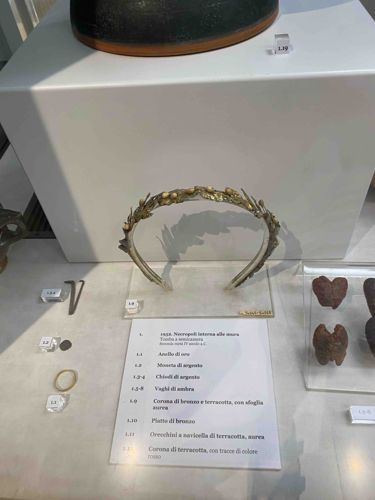
Bronze and Terracotta Crown with Gold Leaf (Corona di bronzo e terracotta, con sfoglia aurea)
This artifact is a wreath or crown, identified as item 1.9 in the exhibition, described as a 'Corona di bronzo e terracotta, con sfoglia aurea' (Crown of bronze and terracotta, with gold leaf). The item presents as a circular band, seemingly open at the back, mimicking a botanical wreath. Its construction appears to involve a base of bronze, which provides the structural form, supporting individually formed leaves and berries. The leaves, visible along the upper perimeter, are designed to emulate natural foliage, showcasing delicate veining and varying angles to suggest organic growth. Interspersed amongst the leaves are clusters of small, spherical elements, likely representing berries or fruit, which appear to be made of terracotta. A notable distinguishing feature is the presence of gold leaf (`sfoglia aurea`) applied to surfaces, particularly visible on some of the leaves, which would have originally provided a lustrous, golden appearance. The overall color palette is muted, with dull silver-grey tones predominating on the bronze elements, indicating tarnishing or oxidation consistent with age and burial. The terracotta elements are a light, earthy tone, while the gold leaf retains some of its original metallic sheen in certain areas. There are no obvious signs of significant damage such as breaks or large chips, but wear and patina are evident across the metallic and terracotta surfaces, attesting to its antiquity. The craftsmanship suggests meticulous attention to detail in replicating natural forms, indicating a high level of artisanal skill for its presumed period. The reference to 'Necropoli interna alle mura, Tomba a semicamera, secondo meta IV secolo a.C.' suggests an Etruscan or Roman origin from the second half of the 4th century BC, placing it firmly in the Classical antiquity period.
AI-Generated Appraisal Disclaimer
Estimated Value
$150,000 - $250,000
Basic Information
Category
Ancient Artifact - Headwear
Appraised On
December 7, 2025
Estimated Value
$150,000 - $250,000
Additional Details Provided By Owner
User Provided Information
Corona di bronzo e terracotta, con sfoglia aurea
Item Description
This artifact is a wreath or crown, identified as item 1.9 in the exhibition, described as a 'Corona di bronzo e terracotta, con sfoglia aurea' (Crown of bronze and terracotta, with gold leaf). The item presents as a circular band, seemingly open at the back, mimicking a botanical wreath. Its construction appears to involve a base of bronze, which provides the structural form, supporting individually formed leaves and berries. The leaves, visible along the upper perimeter, are designed to emulate natural foliage, showcasing delicate veining and varying angles to suggest organic growth. Interspersed amongst the leaves are clusters of small, spherical elements, likely representing berries or fruit, which appear to be made of terracotta. A notable distinguishing feature is the presence of gold leaf (`sfoglia aurea`) applied to surfaces, particularly visible on some of the leaves, which would have originally provided a lustrous, golden appearance. The overall color palette is muted, with dull silver-grey tones predominating on the bronze elements, indicating tarnishing or oxidation consistent with age and burial. The terracotta elements are a light, earthy tone, while the gold leaf retains some of its original metallic sheen in certain areas. There are no obvious signs of significant damage such as breaks or large chips, but wear and patina are evident across the metallic and terracotta surfaces, attesting to its antiquity. The craftsmanship suggests meticulous attention to detail in replicating natural forms, indicating a high level of artisanal skill for its presumed period. The reference to 'Necropoli interna alle mura, Tomba a semicamera, secondo meta IV secolo a.C.' suggests an Etruscan or Roman origin from the second half of the 4th century BC, placing it firmly in the Classical antiquity period.
Related Tags
Get Your Items Appraised
Instant estimates of your treasures with AI-powered instant appraisals